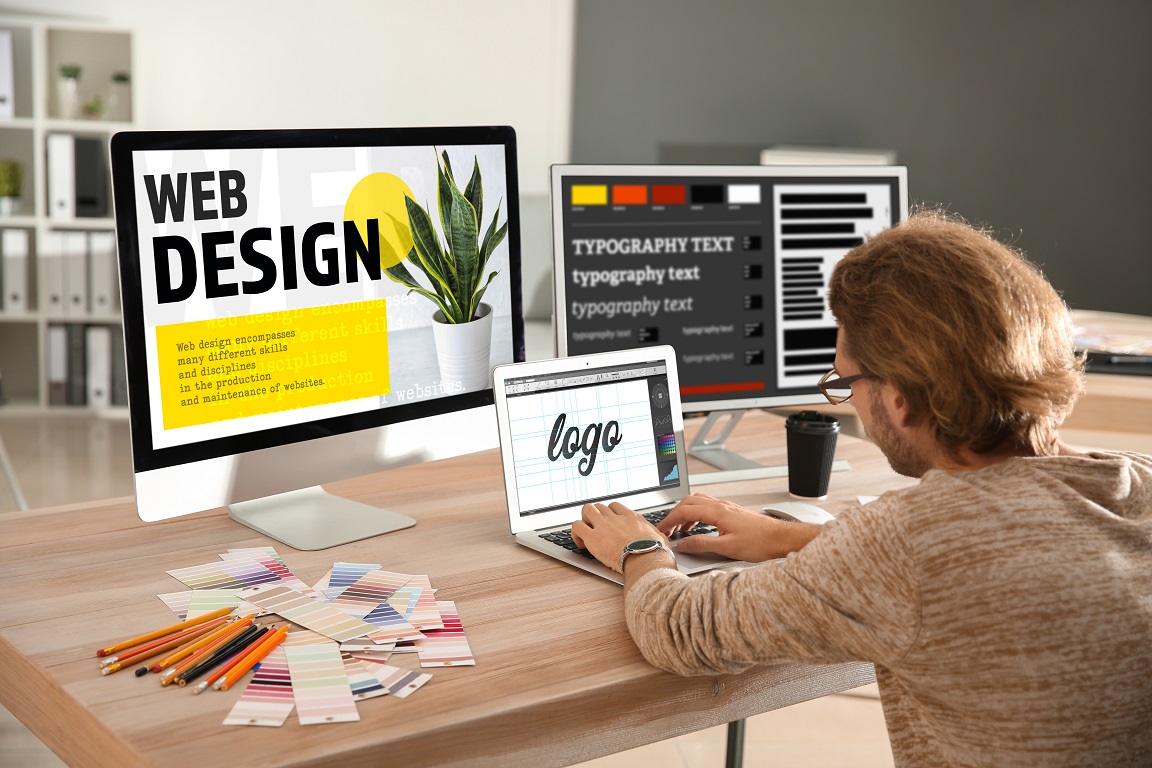The Value of User Experience in Efficient Web Design Strategies
User experience (UX) functions as a keystone in effective web design strategies. It forms just how individuals interact with a website, affecting their contentment and chance of returning. A properly designed UX can enhance involvement via user-friendly navigation and responsive designs. However, neglecting these facets may result in stress and raised bounce prices. Comprehending the ins and outs of UX is vital for developers intending to create compelling digital experiences that reverberate with varied target markets. What factors really drive successful user interaction?
Recognizing User Experience and Its Impact on Design
Although user experience (UX) is commonly regarded as a plain element of web design, it essentially shapes how customers communicate with a site. UX incorporates all aspects of the user's interaction, consisting of functionality, availability, and general complete satisfaction. A positive UX cultivates engagement, encouraging individuals to explore the site and return in the future. Conversely, an adverse experience can cause frustration, causing high bounce prices and shed chances for conversion.
Design components like navigation, web content, and layout organization play critical duties in forming this experience. Efficient UX style expects user needs and preferences, ensuring that information is conveniently available and visually attractive. In addition, understanding user behavior with analytics can give important understandings, informing layout choices that improve usability. Inevitably, a thorough understanding of UX permits designers to create internet sites that not only bring in users yet likewise advertise significant interactions that line up with business objectives and user expectations.
Secret Principles of Effective User Experience
Reliable user experience depends upon a number of crucial concepts that enhance site performance and interaction. User-friendly navigating design, receptive layout essentials, and the relevance of aesthetic power structure are crucial aspects that contribute to a smooth interaction in between customers and internet content. Understanding these concepts permits designers to create more obtainable and user-friendly electronic settings.
Intuitive Navigating Design
When users experience a web site, user-friendly navigating layout functions as an important portal to their total experience. Reliable navigating allows individuals to effortlessly locate the details they seek, enhancing their communication with the site. Key concepts include clear labeling, rational organization, and consistent positioning of navigation aspects. Labels need to be simple, allowing customers to predict the content they will certainly find. A well-structured pecking order assists users recognize the relationship in between different sections, guiding them through the web site seamlessly. Additionally, responsive food selections and quickly obtainable links add to a fluid experience across tools. By focusing on user-friendly navigation, designers can greatly decrease user frustration and increase involvement, eventually cultivating a favorable understanding of the internet site and its material.
Responsive Design Essentials
A well-structured navigation system normally brings about the demand for a responsive design, which is necessary in today's varied electronic landscape. A receptive layout assurances that websites function seamlessly throughout different devices, consisting of mobile phones, tablet computers, and desktop computers. This flexibility boosts user experience by allowing web content to be visually meaningful and quickly available, no matter of display size. Trick concepts of responsive layout consist of liquid grids, adaptable pictures, and media inquiries, which help with excellent watching. Additionally, prioritizing touch-friendly aspects improves communication on mobile tools. By executing a receptive design, designers can accommodate customers' requirements, decrease bounce rates, and rise involvement. Ultimately, a well-executed responsive layout promotes a favorable user experience, encouraging site visitors to discover the internet site additionally.
Visual Power Structure Value
Aesthetic power structure plays a vital duty in leading individuals via an internet site, ensuring that important info catches their focus first. By strategically using size, spacing, contrast, and color, developers can produce a clear pathway for users to follow. Bigger components frequently attract the eye, indicating their relevance, while contrasting shades can highlight contact us to activity. In addition, regular positioning and grouping of relevant material enhance comprehension, making navigating intuitive. Reliable usage of visual hierarchy not only enhances use yet also supports the general visual of the site, fostering a favorable user experience. When individuals can easily identify one of the most critical details, they are most likely to involve with the content, resulting in boosted contentment and communication with the internet site.
The Duty of Usability in Web Design
Usability plays a necessary role in web design, especially via navigation simplicity and adherence to availability standards. Efficient navigating improves user satisfaction by permitting site visitors to find details quickly and without effort. Conference ease of access standards guarantees that all individuals, no matter of their capabilities, can efficiently connect with the website.
Navigation Simpleness
Simpleness in navigation stands as a foundation of effective web design, considerably influencing user experience. A streamlined navigation system allows customers to discover info promptly and with ease, decreasing frustration and enhancing contentment. Clear labeling and logical framework are essential elements, leading users effortlessly via the web site. Redundant web links or extremely intricate menus can disorient individuals, resulting in increased bounce rates. In addition, mobile responsiveness has to be taken into consideration, guaranteeing navigation stays uncomplicated across gadgets. Prioritizing important web pages and minimizing mess further sustains user involvement. Efficient navigating not only cultivates a positive experience however also motivates customers to explore the site better, eventually leading to higher conversion rates. Hereof, navigation simpleness acts as an essential consider the total effectiveness of web design approaches.
Ease of access Criteria
User involvement is considerably enhanced when websites adhere to availability standards, making certain that all customers, despite their abilities, can browse and connect effectively. Compliance with these standards not only widens the target market but likewise boosts general user fulfillment. Available design includes functions such as message choices for pictures, key-board navigating, and enough color contrast, which assist in use by individuals with handicaps. Additionally, carrying out these criteria can positively impact search engine optimization (SEO) by enhancing site framework and quality. As web design evolves, focusing on availability becomes vital in fostering a comprehensive digital atmosphere. By accepting these requirements, designers add to an extra equitable net, inevitably driving user loyalty and interaction.
Relevance of Responsive Style for User Engagement
As consumers significantly access websites through a selection of devices, the significance of responsive style comes to be vital for involving customers effectively. Responsive layout guarantees that a website adjusts flawlessly to different display sizes, providing a perfect watching experience no matter the gadget used. This flexibility boosts user interaction by helping with much easier navigating and communication with content.
When users come across a site that is receptive, they are most likely to remain much longer, explore additionally, and return in the future. A properly designed responsive design decreases the disappointment commonly connected with zooming and scrolling on smaller screens, consequently decreasing bounce rates. In addition, responsive design can favorably influence online search engine rankings, as search engines focus on mobile-friendly internet sites. In today's electronic landscape, where mobile usage proceeds to climb, executing receptive style is not simply valuable, however important for maintaining user interaction and ensuring a favorable experience across all gadgets.
Enhancing Load Times for Better User Complete Satisfaction

To boost load times, internet developers ought to prioritize maximizing images, leveraging browser caching, and decreasing HTTP requests. In addition, using Content Shipment Networks (CDNs) can accelerate material shipment by dispersing it across numerous geographical places. Streamlining code, such as compressing CSS and JavaScript documents, even more adds to faster filling speeds.
Eventually, a dedication to boosting lots times not just boosts user fulfillment yet additionally reinforces brand name commitment and boosts the chance of repeat brows through. A swift, seamless experience is essential for keeping users and promoting positive interactions.
The Impact of Visual Hierarchy on User Interaction
Visual power structure offers as a crucial element in leading user interaction on a site. By arranging material in such a way that focuses on details visually, designers can influence how individuals involve and browse with a website. This pecking order is established through various design strategies, including size, contrast, spacing, and shade. Larger font styles or bold colors draw interest to vital elements, such as telephone calls to action or headings, while restrained colors and smaller sized font styles can show secondary information.
Efficient visual pecking order aids customers quickly recognize what is crucial, decreasing cognitive lots and improving use. It enables intuitive navigating, making it easier for users to find what they require without frustration. As individuals engage with an internet site, a well-structured aesthetic hierarchy cultivates a more enjoyable experience, ultimately bring about greater interaction and conversion rates. Developers need to focus on these concepts to develop an user-centered and reliable internet environment.
Gauging User Experience: Tools and Methods

Regularly Asked Concerns
Exactly How Can I Boost My Site's User Experience on a Budget?
To enhance an internet site's user experience on a budget, one can optimize page tons rate, streamline navigation, apply receptive style, enhance content clearness, and collect user responses for continuous refinements, ensuring a gratifying site visitor experience.
What Prevail User Experience Blunders to Prevent in Web Design?
Common user experience errors in web design consist of messy layouts, inadequate navigation, slow-moving loading times, lack of mobile responsiveness, overlooking ease of access, irregular branding, and stopping working to prioritize user responses - Web Design Agency. Each can greatly hinder overall site performance
Exactly how Often Should I Update My Website for Better User Experience?
Websites need to be upgraded consistently, preferably every couple of months, to maintain optimal user experience. Regular updates aid address usability issues, revitalize content, and adapt to altering user demands, guaranteeing the website stays pertinent and appealing.

Can User Experience Effect Search Engine Optimization Rankings on My Site?
User experience can substantially impact SEO rankings, as online search engine focus on sites that offer seamless navigation, quick filling times, and interesting content. A favorable user experience can result in reduced bounce rates and higher search visibility.
What Duty Does Availability Play in User Experience Layout?
Access plays a necessary function in user experience layout by making certain that all individuals, no matter capabilities, can browse and connect with a site properly. This inclusivity boosts overall fulfillment and interaction amongst diverse customers.
User experience (UX) is frequently perceived as a mere facet of web design, it basically shapes how users interact with a site. User interaction is significantly boosted when websites adhere to ease of access requirements, guaranteeing that all individuals, no matter of their abilities, can browse and interact effectively. Measuring user experience (UX) is necessary for comprehending exactly how properly a web site meets the demands of its users. Furthermore, functionality screening, where real individuals navigate the website while viewers keep in mind Web Design Agency problems, supplies straight feedback on user experience. Usual user experience errors in web layout consist of chaotic layouts, inadequate navigating, slow-moving filling times, lack of mobile responsiveness, overlooking accessibility, irregular branding, and failing to prioritize user responses.